Have you ever drilled a hole in the wrong spot while working on a woodworking project? Or perhaps you’ve had to remove a piece of hardware from a piece of wood, leaving an unsightly hole behind.
Whatever the reason, filling a hole in wood and redrilling can seem like a daunting task, especially if you’re new to woodworking.
But don’t worry! With the right tools and techniques, you can quickly fill a hole in the wood and redrill precisely, restoring your project to its former glory.
I’ll show you how I do it. The hole can be filled with sawdust and then compressed. A nail can be used to ensure the hole is filled with enough sawdust.
After that, add some super glue. Once the surface has dried, sand it flush with the remainder of the wood surface. You can then drill again. I use that method, and it seems to work pretty well.
Different Ways Explained To Fill A Hole In Wood And Redrill
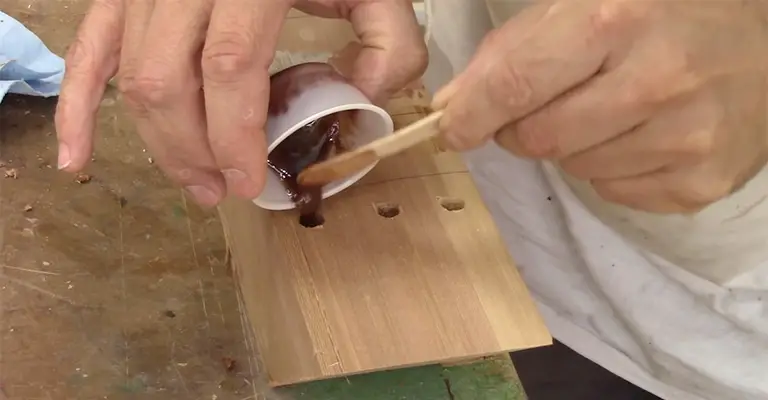
Many processes must be performed before the wood can be used to make anything. Thus, it may become damaged with marks, holes, cracks, and dents. You cannot extend the life of your wooden structures by not covering them correctly.
It is because dust and moisture can penetrate these gaps and severely damage your woodwork. You have a few options to fill up holes in wood before drilling for screws.
- First, you can fill in old screw holes with wood filler to cover them permanently.
- Second, you can make your own wood filler by mixing wood glue and sawdust.
- Finally, wooden plugs can also be used to fill holes.
If you need to redrill a filled surface effectively, add a toothpick into the gap.
1. Covering Holes Through Wood Plugs
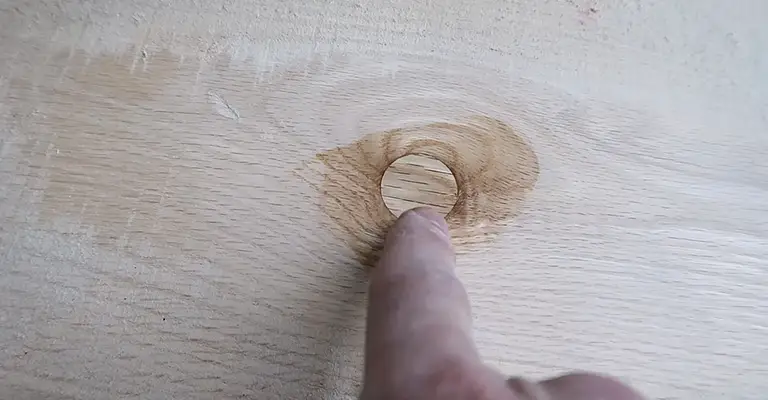
There’s a lot of interest these days in using wood plugs as the newest technique. These wood plugs require just a few minutes to make and can be purchased at a local shop or online.
It is often the case that craftsmen use wood plug cutters for this purpose. The process simply involves plugging the hole with a wooden plug. This method allows large, deep holes to be filled quickly and easily.
Steps To Follow
Using these simple steps, you can insert wooden plugs with ease. It is essential to wear safety gloves since glue might stick to your hands.
- You should choose a wood plug that fits snugly into the hole.
- Glue the holes’ sides after selecting the wood.
- Adjust the wood plug inside the hole as necessary.
- The plug can be pushed deep into the hole with a hammer or forcefully drawn in with the hammer
- Remove any extra wood from the plugs once the glue has dried with a handy saw.
- Finally, sand the area of plugging to make it look OK.
2. Filling Holes Through Wooden Scrap And Glue
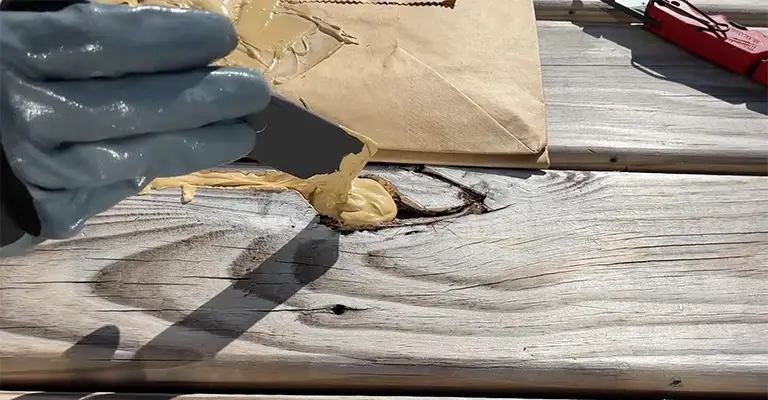
Keep sawdust and wooden scraps instead of throwing them away. Make free homemade wood filler with them. To fill in holes.
Filling holes with wooden scraps and glue is the easiest and most effective method. These filters are invaluable when you run out of commercial fillers.
You do not need to buy more, just prepare it at home. It is possible to find so many wood glues in markets today. In general, they do a good job, but their drying times and results vary a bit.
Steps To Follow
Note: Make sure you wear gloves and a mask before you get started because the wood filler is a dusty business.
- Before a project begins, collect sawdust or fine wood scraps. Sandpaper and an electric sander work well, but you can make your own if you don’t have either. Ensure the sawdust you use is the same colour as the wood you are filing.
- Keep your collection clear of big scraps by filtering them. You should also clean the collected material to remove any dust.
- Taking a mixing bowl, place sawdust particles inside. Slowly add glue to the bowl. A mixing stick should be used to continuously mix the ingredients. Once the mixture becomes thick, let it stand for a few minutes.
Note: (Do all this process instantly; otherwise, it may harden)
- By dropping the mixture from a spoon, you can determine its consistency. You should not see any running from it. You shouldn’t apply it if the mixture becomes thick. I recommend trying another batch.
- To apply the mixture, insert it into cracks and holes using wood putty first.
- Make sure the mixture is even, and remove excess with a putty knife or sandpaper.
- Ensure that the surface dries completely before touching it. Those remaining mixtures cannot be used later, so dispose of them or waste them.
- When it is dry, lightly sand it.
- It is finally time to clean up the area with a soaked cloth. We are now ready to redrill or paint it.
3. Filling Holes Through Wood Fillers
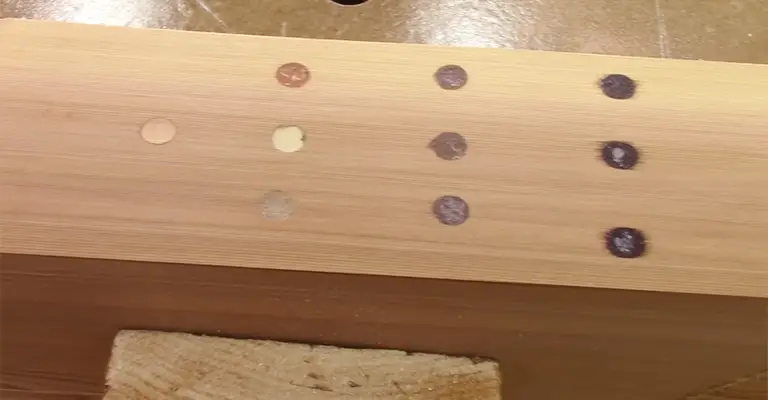
A common feature of furniture is screw holes. Various wood fillers can be found at hardware stores. Across the board, all of these methods are effective at filling jobs, and the drying time, preparation method, and results are very similar.
It is possible to choose from a variety of wood fillers. They generally accomplish the same task with slightly varied preparation and results.
Vinyl:
You can choose Vinyl wood filler if you want quick and efficient results. The material is highly flammable and must be used in minimal quantities.
Gypsum:
In the case of surfaces next to being painted, gypsum wood filler is usually used.
Cellulose:
In general, it is a good choice when it comes to outdoor furniture and flooring. Despite its simplicity, affordability, and long-lasting nature, it is easy to use.
Epoxy:
The advantages of epoxy are that it dries rapidly and that it is not affected by moisture.
Moreover, when completely dry, it can be nailed or drilled without causing any cracks or damage, making it the best choice when the wood is exposed to harsh weather. Right now, we are focusing on the wood filler that is easily redrilled.
Its weather-resistant properties make Epoxy Wood Filler an outstanding choice for this purpose. However, new products available on the market are not epoxy but can still be redrilled.
How To Fill Holes Through Wood Fillers?
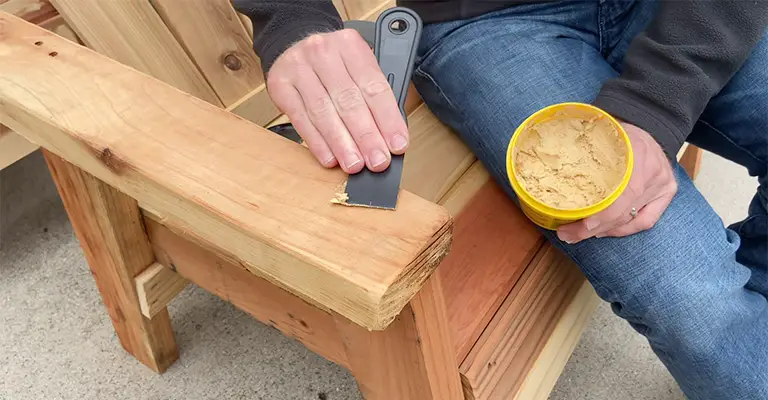
There are a lot of challenges involved in hiding gaps. In order to accomplish this procedure, you need to follow the steps outlined below.
- Get a scraper and remove any paint marks from the surface.
- Using sandpaper, clean the area thoroughly.
- If any debris or sawdust remains, use a half-soaked cloth to wipe it away.
- Put the filler into the hole according to its size.
- As wood fillers contract when dry, you should put in extra filler.
- Spread wood filler over the hole using a putty knife. The hole must be filled completely by exerting pressure. Level it by using sandpaper.
- Once the filler is dry, clamp it and wait for it to dry. There are many different types of products, so drying time can vary from half an hour to eight hours.
- Once the paint has dried, you can use the sandpaper again. Sanding the filler until it becomes level above the hole is essential.
- You can also use your hand to measure the surface level where the filler has been applied. Use the same procedure to reapply the filler if it is not smooth.
How To Redrill Wood After Filing It?
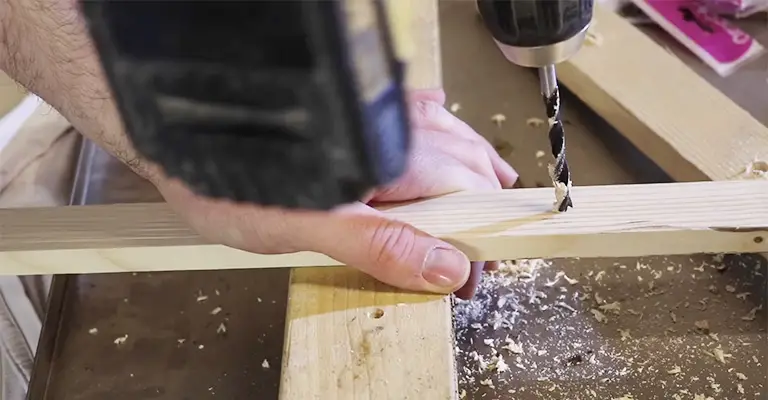
Some projects may require you to redrill the filled area for screws or nails. In the event that redrilling is not completed properly, there is a risk that the joint will crack. After wood filing, you’ll need to redrill without much hassle. Here are some tips.
Add a piece of wood or even a toothpick to increase the strength when filing. Fillers for wood will be more powerful with this additive.
If you plan to plug your holes, make them bigger. Covering and smoothing larger holes is much easier.
Whenever you redrill, use screws that are wider than the previous ones. Using this method, screws can be inserted easily and without causing damage.
When drilling into the newly filled holes, you must follow some safety measures to prevent cracking. Following are the steps for redrilling wood:
Step 1: Add Some Toothpicks Or Matchsticks
If you plan on redrilling the area you recently filled, add two or three matchsticks or toothpicks first. It will strengthen the filling.
Step 2: Make A Bit Larger Hole
Make a larger hole if you want to use wood plugs to fill the holes and redrill where the wood plugs have been successfully placed.
Consequently, the hole becomes more consistent and filling it becomes much easier. Additionally, it will facilitate smoothing the surface.
Step 3: Mark The Position
Make a pencil mark on the surface where you intend to redrill before you begin drilling. The hole will be drilled in the correct location this way.
Step 4: Redrill The Hole
Take a driller and place the drill head on the wood surface at the marked point. Make sure you drill slowly at first.
It is important not to drill too quickly, as this will ruin your newly filled holes. Ensure that you drill at the right angle and do not drill so deep.
Step 5: Use A Wider Screw Diameter
Whenever you redrill or screw in new screws, make sure the screws are wider than the ones that were previously used. Doing this will reduce the chance of the wood cracking again.
Step 6: Clean It Up
To extend the shelf life of a screwed area, polish the area surrounding it after redrilling and screwing.
Can You Screw A Filled Area With Wood Filler?
All the glue must go into the wood hole without leaving tiny air bubbles. In this way, the screw can be loosed. When dry, use an adhesive that does not become brittle.
There is something especially pleasing about wood particles and glue mixtures as fillers. Adding a pilot hole is necessary before installing the screw to ensure your screw is driven in the right direction and to prevent damage to sensitive wood parts.
How Do You Fill A Stripped Screw Hole In Wood?
A rope the size of a bare screw hole can be used to wrap wood filler around your fingers. Once this has been done, fill the hole so that it is even with the surface.
After the paint has dried, mark the pre-planned hole, then drill a slightly smaller hole than the screw’s width. Hopefully, the cured filler will not be dissolved.
For large and dirty areas, Bondo can be used outdoors. Spread the color around by rubbing and smearing. The wood filler does not congeal and holds the screw in a convex shape.
Can You Redrill Into Wood Filler?
Certainly, you can redrill the wood filler. The most important aspect of drilling infill is to use filler correctly and to allow it to dry completely.
Although drilling infill is relatively straightforward, it can still be quite successful if it’s done correctly. You may be left with nothing but a huge mess if the glue has not completely dried.
Using two-component epoxy wood putty and reusable wood putty prevents drilling cracks. Make sure the depth of the hole is considered when drilling wood filler to secure the screw.
Final Words
It is common for wood furniture, wood flooring, and other wood-made items to crack and hole over time. Repairing this kind of damage can be done with wood filler.
To make the repaired area as smooth as possible, wood filler is applied over the damaged area, let dry, and then sanded to make it level.







